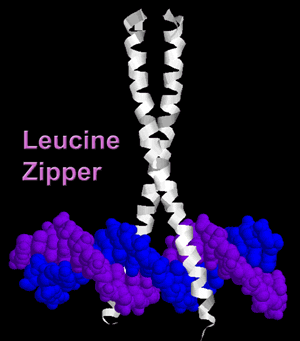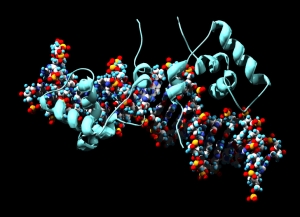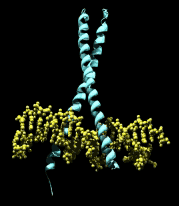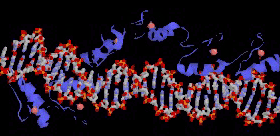Introduction to Protein-DNA Interactions:
Focus on Regulatory Proteins
 In living cells, there are many functions that take place simultaneously to keep the cell alive. Many types of molecules: water, proteins, salts, small molecules, DNA, and RNA are all present in cells, making them complex environments. The cells are able to survive because the molecules, such as DNA and proteins, are all adapted to their functions very uniquely and interact very specifically with their partner molecules. One type of interaction that is very important in cells, is the interaction between proteins and DNA. There are other interactions, for example between different proteins, between proteins and RNA, or between proteins and small molecules. The topic of this structure tutorial is the interactions between proteins and DNA. In living cells, there are many functions that take place simultaneously to keep the cell alive. Many types of molecules: water, proteins, salts, small molecules, DNA, and RNA are all present in cells, making them complex environments. The cells are able to survive because the molecules, such as DNA and proteins, are all adapted to their functions very uniquely and interact very specifically with their partner molecules. One type of interaction that is very important in cells, is the interaction between proteins and DNA. There are other interactions, for example between different proteins, between proteins and RNA, or between proteins and small molecules. The topic of this structure tutorial is the interactions between proteins and DNA.
The interaction between proteins and DNA is important in such cellular events as DNA packing, DNA replication, DNA transcription, and gene regulation. Here we will focus on proteins involved in the regulation of gene expression. The regulation of gene expression is crucial for the healthy living of any organism. The cell needs to be able to respond to the constantly changing environment.
So far there have been found three basic protein structural motifs of regulatory proteins that are involved in recognizing specific DNA sequences. These are the helix-turn-helix motif, the leucine-zipper motif, and the zinc-finger motif. We will illustrate these binding motifs with three proteins complexed with their DNA.
Helix-turn-helix motif
 The helix-turn-helix motif consists of about 20 amino acids. The basic form is that of 2 helices separated by a turn. One helix, the stabilization helix, is there to stabilize the other helix, the recognition helix. The helix-turn-helix motif will be illustrated with the lac-repressor-DNA complex. The helix-turn-helix motif consists of about 20 amino acids. The basic form is that of 2 helices separated by a turn. One helix, the stabilization helix, is there to stabilize the other helix, the recognition helix. The helix-turn-helix motif will be illustrated with the lac-repressor-DNA complex.
 Leucine zipper motif Leucine zipper motif
The leucine zipper is an interesting structure made up of two a-helical segments of protein that have leucines facing each other along the length of the helices, allowing them to dimerize and form a symmetric interface that can bind to the DNA on both sides of the double helix (see figure). The leucine zipper motif will be illustrated with the GCN4 (protein)-AP1 (DNA) complex, a protein involved in activating transcription in yeast.
Zinc-finger motif
 The Zinc finger motif includes a metal, Zinc, in the DNA-binding motif. The Zinc helps to stabilize the three-dimensional structure of the Zinc-finger. The Zinc is coordinated either with the sulfur in cysteine, or one of the nitrogens in the histidine imidazole sidechain. The zinc-finger motif will be illustrated with the Transcription Factor IIIA-DNA complex from the clawed frog Xenopus laevis. The Zinc finger motif includes a metal, Zinc, in the DNA-binding motif. The Zinc helps to stabilize the three-dimensional structure of the Zinc-finger. The Zinc is coordinated either with the sulfur in cysteine, or one of the nitrogens in the histidine imidazole sidechain. The zinc-finger motif will be illustrated with the Transcription Factor IIIA-DNA complex from the clawed frog Xenopus laevis.
Now on to the molecular tour of DNA regulatory proteins!
Relevant Units
Signal Transduction animation
Central Dogma of Biochemistry animation
|







